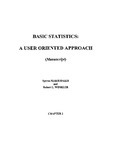| dc.contributor.author | Makridakis, Spyros | |
| dc.contributor.author | Winkler, Robert L. | |
| dc.date.accessioned | 2015-12-16T13:24:47Z | |
| dc.date.available | 2015-12-16T13:24:47Z | |
| dc.date.issued | 1981 | |
| dc.identifier.uri | http://hdl.handle.net/11728/6665 | |
| dc.description.abstract | Table 2.1 shows the ages of the 230 students who entered INSEAD during the 1980/81 academic year. What can you make out of these numbers? Obνiously, the answer will depend upon who you are. Unless you haνe some objectiνe ίn mind, you will not bother further examining TabIe 2.1. But let us assume you are the academic director of INSEAD. Then you may want to know the aνerage age of the students and many other characteristics that the data might reνeal. Is the student population of this year older or younger than that of preνious years? What is the most common age among students? Are there any students much younger or much older than the aνerage? If there are, it may be that they wiIl not fit ίn weIl with the great majority of students. Are the νarious age groups distributed eνenly, or are some ages predominant ίn the 230 students? | en_UK |
| dc.language.iso | en | en_UK |
| dc.rights.uri | http://creativecommons.org/licenses/by-nc-nd/4.0/ | en_UK |
| dc.subject | Research Subject Categories::SOCIAL SCIENCES::Business and economics | en_UK |
| dc.subject | Basic statistics | en_UK |
| dc.title | Basic statistics : a user oriented approach (manuscript) | en_UK |
| dc.type | Book chapter | en_UK |


